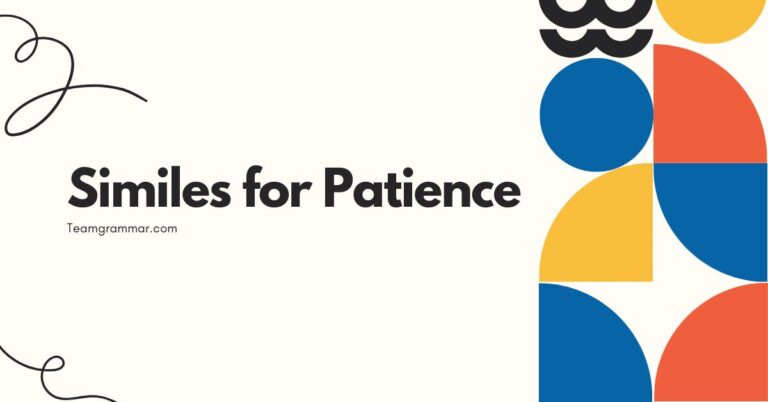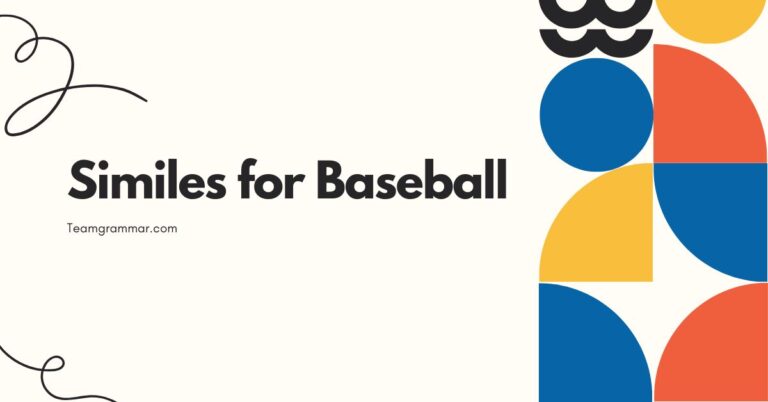25 Similes for Death: A Comprehensive Guide to Figurative Language
Understanding how to use similes to describe death is essential for enriching your writing and comprehension of literature. Similes, by comparing death to other concepts, allow for a more nuanced and evocative expression of this complex subject.
This article will explore the definition, structure, types, and usage of similes for death, providing numerous examples and practical exercises. Whether you are a student, writer, or simply interested in language, this guide will enhance your understanding and ability to use similes effectively.
Table of Contents
- Introduction
- Definition of Simile
- Structural Breakdown of Similes
- Types of Similes for Death
- Examples of Similes for Death
- Usage Rules for Similes
- Common Mistakes When Using Similes
- Practice Exercises
- Advanced Topics in Similes
- Frequently Asked Questions
- Conclusion
Definition of Simile
A simile is a figure of speech that directly compares two different things, typically using the words “like” or “as.” It’s a powerful tool for creating vivid imagery and conveying complex ideas in a relatable way. In the context of death, similes can soften the blow of the subject, add emotional depth, or provide a fresh perspective.
Similes differ from metaphors, which state that one thing *is* another, while similes merely suggest a resemblance.
Similes serve several important functions in language. They enhance descriptive writing, making it more engaging and memorable.
They also clarify abstract concepts by relating them to more concrete ideas. In literature, similes are frequently used to evoke specific emotions and create a deeper connection with the reader.
When used to describe death, similes can transform a potentially stark and frightening topic into something more understandable and even beautiful.
The primary function of a simile is to draw a comparison between two dissimilar things, highlighting a shared quality or characteristic. This comparison helps the audience understand or visualize the subject more clearly.
For example, saying someone is “as brave as a lion” helps the listener understand the person’s bravery by associating it with the known bravery of a lion. In the context of death, a simile might compare the stillness of death to the stillness of a silent forest, helping the reader grasp the profound quietness associated with passing.
Structural Breakdown of Similes
A simile typically consists of three key components: the subject (the thing being described), the linking word (usually “like” or “as”), and the object of comparison (the thing to which the subject is being compared). Understanding these components is crucial for constructing effective and meaningful similes.
The basic formula for a simile is:Subject + Linking Word + Object of Comparison. For example, in the simile “Death is like a long sleep,” “Death” is the subject, “like” is the linking word, and “a long sleep” is the object of comparison.
The power of the simile lies in the connection drawn between these elements.
Let’s break down each component further:
- Subject: This is the topic being described or clarified. In our context, it is often death itself or aspects related to death, such as dying, grief, or the afterlife.
- Linking Word: The most common linking words are “like” and “as.” These words signal that a comparison is being made, rather than a direct identification. Other less common linking words can include “than” or phrases such as “similar to.”
- Object of Comparison: This is the element to which the subject is being compared. It provides a relatable or understandable reference point for the audience. The effectiveness of a simile depends on the clarity and relevance of this comparison.
Consider the simile: “He was as pale as death.” Here, “He” (the person) is the subject, “as” is the linking word, and “death” is the object of comparison. The simile suggests that the person’s pallor is similar to the paleness associated with death, creating a vivid image of their sickly appearance.
Types of Similes for Death
Similes for death can be categorized based on the aspect of death they emphasize. These categories include similes focusing on the physical aspects, the emotional impact, the finality, and the transition to an afterlife (or lack thereof).
Understanding these categories can help you choose the most appropriate simile for your specific context.
Similes Emphasizing Physical Aspects
These similes focus on the physical characteristics associated with death, such as stillness, coldness, or decay. They often evoke a sense of realism and can be particularly effective in descriptive writing.
Similes Highlighting Emotional Impact
These similes explore the emotional consequences of death, such as grief, loss, and sorrow. They can be used to convey the profound impact of death on those left behind.
Similes Focusing on Finality
These similes emphasize the irreversible nature of death, highlighting its role as the ultimate end. They can create a sense of closure or resignation.
Similes Referencing Transition or Afterlife
These similes explore the concept of death as a transition to another state, whether it be an afterlife, a spiritual realm, or simply nothingness. They often offer a sense of hope or philosophical reflection.
Examples of Similes for Death
The following tables provide extensive examples of similes for death, organized by the categories discussed above. Each category includes a variety of similes to illustrate the range of possibilities and the different effects they can create.
These examples will help you understand how to construct your own similes and use them effectively in your writing.
Similes Emphasizing Physical Aspects
This table presents similes that focus on the physical characteristics associated with death, such as stillness, coldness, and decay. These similes aim to create a vivid and realistic depiction of the physical state of death.
| Simile | Explanation |
|---|---|
| As still as death | Highlights the complete lack of movement associated with death. |
| As cold as a corpse | Emphasizes the drop in body temperature after death. |
| Like a stone, lifeless | Compares the body to an inanimate object, devoid of life. |
| As silent as a tomb | Focuses on the profound quietness of a burial place. |
| His face was like a mask of death | Describes the rigid and unchanging expression often seen in death. |
| She lay as still as a statue | Highlights the immobility of the deceased. |
| The room was as cold as a mortuary | Emphasizes the chilling temperature associated with death. |
| His skin felt like ice | Describes the coldness of the skin after death. |
| Death’s grip is like a vise | Illustrates the unyielding hold of death. |
| He was as pale as a ghost | Compares the pallor of death to the spectral appearance of a ghost. |
| Her body was like a broken doll | Emphasizes the fragility and helplessness of the deceased. |
| The silence descended like a shroud | Compares the silence to a cloth covering a dead body, emphasizing its oppressiveness. |
| He was as stiff as a board | Describes the rigidity of the body after death. |
| Her eyes were as vacant as empty sockets | Highlights the lack of life and expression in the eyes. |
| His breathing was like a faint whisper, barely there. | Describes the shallow and weak breathing that often precedes death. |
| The air hung heavy, like the weight of a tombstone. | Emphasizes the oppressive atmosphere associated with death. |
| She looked as fragile as spun glass. | Compares the fragility of life to the delicate nature of spun glass. |
| His heart stopped, like a clock running out of time. | Illustrates the cessation of life with the image of a stopped clock. |
| The light in his eyes faded, like a dying ember. | Compares the fading of life to the diminishing light of a dying ember. |
| He was as unmoving as a mountain. | Emphasizes the complete lack of movement, suggesting permanence. |
| Her touch was as cold as winter. | Compares the coldness of her touch to the chill of winter. |
| The room smelled like a funeral home. | Associates the scent with the sterile and somber atmosphere of death. |
| His voice was as hollow as an empty well. | Describes the lack of resonance and life in his voice. |
| She was as still as a photograph. | Highlights the frozen, unchanging nature of death. |
| His skin was like parchment, thin and pale. | Compares the texture and color of his skin to old, brittle parchment. |
Similes Highlighting Emotional Impact
This table presents similes that explore the emotional consequences of death, such as grief, loss, and sorrow. These similes aim to convey the profound impact of death on those left behind.
| Simile | Explanation |
|---|---|
| Grief washed over her like a tidal wave | Illustrates the overwhelming nature of grief. |
| Loss felt like a gaping hole in her heart | Emphasizes the emptiness and pain caused by loss. |
| Sorrow clung to him like a shadow | Describes the persistent and inescapable nature of sorrow. |
| Her tears flowed like a river | Highlights the abundance and intensity of her crying. |
| The pain was like a knife twisting in his gut | Conveys the sharp and agonizing nature of grief. |
| He felt as empty as a deserted house | Emphasizes the sense of emptiness and loneliness after a loss. |
| Life felt like a meaningless dream | Describes the sense of disillusionment and lack of purpose after death. |
| The world seemed as gray as a cloudy day | Highlights the dullness and bleakness of the world after a loss. |
| Her heart ached like a physical wound | Compares emotional pain to physical pain, emphasizing its intensity. |
| Memories flooded back like a broken dam | Illustrates the overwhelming rush of memories after a death. |
| He felt as heavy as lead with grief | Describes the burden and weight of sorrow. |
| The silence was as deafening as a scream | Emphasizes the oppressive and unsettling nature of silence after a loss. |
| Hope dwindled like a flickering candle | Describes the gradual loss of hope in the face of death. |
| She felt as lost as a ship without a rudder | Emphasizes the sense of disorientation and lack of direction after a loss. |
| The world seemed as cold as ice. | Highlights the emotional chill and detachment after a loss. |
| His laughter sounded like a distant echo. | Describes the faint and infrequent nature of joy after a death. |
| She felt as though her soul had been ripped apart. | Emphasizes the profound and devastating impact of grief. |
| The days stretched on like an eternity. | Describes the slow and agonizing passage of time after a loss. |
| He felt as numb as if he had been frozen solid. | Illustrates the emotional numbness and detachment after a death. |
| Her voice was as fragile as a whisper. | Describes the weakness and vulnerability in her voice due to grief. |
| The memories haunted him like ghosts. | Compares the persistent and unsettling nature of memories to haunting spirits. |
| He felt as though he was drowning in sorrow. | Emphasizes the overwhelming and suffocating nature of grief. |
| Her smile was as rare as a rainbow in the desert. | Highlights the infrequency and preciousness of joy after a loss. |
| The pain lingered like a scar. | Compares the lasting impact of grief to a permanent scar. |
| He felt as though a part of him had died with her. | Emphasizes the profound sense of loss and incompleteness. |
Similes Focusing on Finality
This table presents similes that emphasize the irreversible nature of death, highlighting its role as the ultimate end. These similes can create a sense of closure or resignation.
| Simile | Explanation |
|---|---|
| Death is like a final curtain call | Compares death to the end of a performance, emphasizing its finality. |
| Life extinguished like a candle in the wind | Illustrates the sudden and irreversible end of life. |
| Death is like the closing of a book | Emphasizes the completion of a life story. |
| As final as the setting sun | Compares death to the daily end of the sun’s journey, highlighting its inevitability. |
| Death is like the end of a long journey | Emphasizes the culmination of life’s experiences. |
| His fate was sealed like an envelope | Describes the irrevocability of his destiny. |
| Death is like the last note of a song | Emphasizes the conclusion of a life’s melody. |
| As permanent as a stone carving | Compares death to something enduring and unchangeable. |
| Death is like the last page of a calendar | Highlights the completion of time. |
| His life was over, like a game that had ended | Emphasizes the cessation of activity and opportunity. |
| Death is like the final brushstroke on a painting | Compares death to the completion of a work of art. |
| As certain as the turning of the seasons | Highlights the inevitability and naturalness of death. |
| Death is like the last line of a poem | Emphasizes the conclusion of a creative expression. |
| His time was up, like a clock that had run out of power | Illustrates the cessation of life with the image of a stopped clock. |
| Death is as inevitable as taxes. | Compares death to something universally unavoidable. |
| His story ended, like a book falling shut. | Emphasizes the finality of his life’s narrative. |
| Death is like the period at the end of a sentence. | Highlights the definitive end of life’s statement. |
| His life was as finished as a building razed to the ground. | Emphasizes the complete and irreversible end of his existence. |
| Death is like the last grain of sand in an hourglass. | Illustrates the inevitable depletion of life’s time. |
| His journey ended, like a train arriving at its final destination. | Compares death to the conclusion of a long voyage. |
| Death is as final as a full stop. | Emphasizes the absolute and conclusive nature of death. |
| His life concluded, like a play ending with its final act. | Compares the ending of life to the concluding act of a dramatic performance. |
| Death is like the last word of a story. | Highlights the end of life’s narrative. |
| His existence ceased, like a flame being snuffed out. | Illustrates the sudden and complete end of life. |
| Death is as certain as sunrise and sunset. | Compares death to the daily and inevitable cycle of nature. |
Similes Referencing Transition or Afterlife
This table presents similes that explore the concept of death as a transition to another state, whether it be an afterlife, a spiritual realm, or simply nothingness. These similes often offer a sense of hope or philosophical reflection.
| Simile | Explanation |
|---|---|
| Death is like a doorway to another world | Suggests that death is a transition to a different realm. |
| Passing on is like entering a long sleep | Euphemistically compares death to peaceful rest. |
| Death is like a homecoming to the spirit | Emphasizes the return of the soul to its origin. |
| Like a butterfly emerging from a cocoon | Compares death to a transformative process. |
| Death is like a ship sailing into the unknown | Suggests a journey into uncharted territory. |
| His soul ascended like a dove | Illustrates the peaceful departure of the soul. |
| Death is like a bridge to eternity | Emphasizes the connection between earthly life and the afterlife. |
| As serene as drifting into a dream | Compares death to a peaceful and pleasant experience. |
| Death is like returning to the source | Suggests a reunion with a divine or universal entity. |
| Her spirit soared like an eagle | Illustrates the freedom and elevation of the soul after death. |
| Death is like stepping into the light | Emphasizes the positive and hopeful aspects of the afterlife. |
| As peaceful as a river flowing into the sea | Compares death to a natural and harmonious transition. |
| Death is like a gentle release | Suggests a freeing and liberating experience. |
| His soul floated away like a feather | Illustrates the lightness and ease of the soul’s departure. |
| Death is like opening a door to endless possibilities. | Emphasizes the potential for new experiences beyond earthly life. |
| As quiet as the whisper of angels | Compares the serenity of death to the peaceful presence of angels. |
| Death is like a voyage to a distant shore. | Suggests a journey to a far-off and unknown destination. |
| His spirit rose like smoke toward the heavens. | Illustrates the upward movement of the soul after death. |
| Death is like finding eternal rest. | Emphasizes the peace and tranquility of the afterlife. |
| As calm as the stillness of a starlit night | Compares death to the peaceful and serene beauty of the night sky. |
| Death is like a return to the garden. | Suggests a return to a state of innocence and peace. |
| Her soul flew away like a songbird. | Illustrates the freedom and beauty of the soul’s departure. |
| Death is like entering a realm of pure light. | Emphasizes the radiant and positive aspects of the afterlife. |
| As gentle as a breeze carrying a leaf | Compares death to a soft and natural transition. |
| Death is like a journey home. | Suggests a return to a place of comfort and belonging. |
Usage Rules for Similes
Using similes effectively requires adherence to certain rules. A good simile should be clear, relevant, and original.
Avoid clichés and ensure that the comparison enhances the reader’s understanding and appreciation of the subject.
- Clarity: The comparison should be easily understood. Avoid obscure or overly complex references.
- Relevance: The object of comparison should have a clear and logical connection to the subject.
- Originality: Strive for fresh and imaginative comparisons. Avoid overused or predictable similes.
- Appropriateness: Consider the context and tone of your writing. Choose similes that are suitable for the subject matter and audience.
For example, instead of saying “He was as dead as a doornail” (a cliché), try “He was as still as a statue,” which offers a more vivid and original image. Similarly, ensure that the comparison makes sense.
Comparing death to something completely unrelated will only confuse the reader.
Common Mistakes When Using Similes
Several common mistakes can undermine the effectiveness of similes. These include using clichés, creating illogical comparisons, and using similes that are too complex or obscure.
| Mistake | Incorrect Example | Correct Example |
|---|---|---|
| Using clichés | He was as dead as a doornail. | He was as still as a statue. |
| Illogical comparison | Death is like a refrigerator. | Death is like a long sleep. |
| Overly complex simile | Death is like the quantum entanglement of two subatomic particles. | Death is like a doorway to another world. |
| Inappropriate tone | Death is like a party. | Death is like a final farewell. |
Avoiding these mistakes will help you create more effective and meaningful similes. Always consider the clarity, relevance, and originality of your comparisons.
Practice Exercises
These exercises will help you practice using similes for death. Each exercise presents a scenario or prompt, and you are asked to create a simile that effectively conveys the intended meaning.
Answers are provided for self-assessment.
Exercise 1: Fill in the Blanks
Complete the following similes by filling in the blanks with appropriate words or phrases.
| Question | Answer |
|---|---|
| 1. Grief washed over her like a __________. | tidal wave |
| 2. He was as pale as __________. | a ghost |
| 3. Death is like a __________ to another world. | doorway |
| 4. Her tears flowed like a __________. | river |
| 5. He felt as empty as __________. | a deserted house |
| 6. Death is like the closing of a __________. | book |
| 7. Sorrow clung to him like a __________. | shadow |
| 8. Life extinguished like a __________ in the wind. | candle |
| 9. He was as still as __________. | death |
| 10. Loss felt like a __________ in her heart. | gaping hole |
Exercise 2: Create Your Own Similes
Write a simile for each of the following prompts.
| Prompt | Example Answer |
|---|---|
| 1. Describe the feeling of losing a loved one. | The pain of losing a loved one is like a knife twisting in your heart. |
| 2. Describe the physical appearance of a dead person. | He was as cold as a corpse laid out on ice. |
| 3. Describe death as a transition. | Death is like a gentle river flowing into the sea. |
| 4. Describe the silence after someone dies. | The silence after he died was as deafening as a scream. |
| 5. Describe the finality of death. | Death is as final as the last page of a book. |
| 6. Describe the emptiness felt after a loss. | She felt as empty as a well after the water runs dry. |
| 7. Describe the fading of life. | His life faded like the last light of dusk. |
| 8. Describe the heaviness of grief. | Grief weighed on him like a mountain on his shoulders. |
| 9. Describe the peace of death. | Death is as peaceful as a quiet night under the stars. |
| 10. Describe the memory of someone who has died. | Memories of her lingered like a sweet perfume. |
Advanced Topics in Similes
For advanced learners, exploring the nuances of similes can lead to more sophisticated and creative writing. This includes understanding how to use extended similes, mixed metaphors, and the cultural significance of certain comparisons.
- Extended Similes: These are similes that are developed over several sentences or paragraphs, providing a more detailed and elaborate comparison.
- Mixed Metaphors: While technically a flaw, intentionally mixing metaphors (and by extension, similes) can create a surreal or humorous effect.
- Cultural Significance: Some comparisons may have different meanings or connotations in different cultures. Being aware of these nuances can help you avoid unintended offense or miscommunication.
Understanding these advanced topics will allow you to use similes with greater precision and creativity, enhancing the impact of your writing.
Frequently Asked Questions
Here are some frequently asked questions about similes and their use in describing death.
- What is the difference between a simile and a metaphor?
A simile compares two things using “like” or “as,” while a metaphor states that one thing *is* another. Similes suggest a resemblance, while metaphors assert an identity.
- Why are similes useful in describing death?
Similes can soften the impact of the subject, add emotional depth, and provide a fresh perspective on a complex and often difficult topic. They allow for a more nuanced and evocative expression.
- How can I avoid using clichés in my similes?
Strive for originality by thinking beyond the common comparisons. Try to find unique and unexpected connections between the subject and the object of comparison.
- What makes a simile effective?
An effective simile is clear, relevant, original, and appropriate for the context. It should enhance the reader’s understanding and appreciation of the subject.
- Can a simile be too complex?
Yes, a simile that is too complex or obscure can confuse the reader and undermine its effectiveness. Aim for clarity and simplicity.
- How do I choose the right linking word (“like” or “as”)?
Generally, “like” is used to compare nouns or pronouns, while “as” is used to compare clauses or phrases. However, the choice often comes down to personal preference and stylistic considerations.
- Are similes only used in literature?
No, similes can be used in various forms of writing, including poetry, prose, journalism, and even everyday conversation. They are a versatile tool for enhancing communication.
- How can I improve my ability to create effective similes?
Practice regularly, read widely, and pay attention to the similes used by other writers. Experiment with different comparisons and seek feedback on your work.
- Is it okay to use similes in formal writing?
Yes, similes can be used in formal writing, but it is important to choose comparisons that are appropriate for the tone and audience. Avoid overly casual or colloquial language.
- How can I use similes to evoke specific emotions?
Choose objects of comparison that are associated with the desired emotions. For example, comparing grief to a “tidal wave” can evoke a sense of being overwhelmed.
- What role do similes play in understanding cultural perspectives on death?
Similes can reflect cultural beliefs and attitudes towards death, offering insights into how different societies view the afterlife, grief, and the meaning of life. Analyzing these similes can provide a deeper understanding of cultural values and perspectives.
- Can similes be used to make death less frightening?
Yes, similes can be used to reframe death in a more comforting or philosophical light. By comparing death to peaceful or transformative processes, they can help alleviate fear and anxiety.
Conclusion
Mastering the use of similes for death is a valuable skill for anyone seeking to express themselves more effectively and creatively. By understanding the definition, structure, types, and usage rules of similes, you can craft powerful and evocative descriptions of this complex subject.
Remember to strive for clarity, relevance, originality, and appropriateness in your comparisons.
Through practice and attention to detail, you can avoid common mistakes and develop a keen eye for creating meaningful and impactful similes. Whether you are a student, writer, or simply interested in language, the ability to use similes effectively will enhance your communication skills and deepen your appreciation of the power of figurative language.
Always consider the impact your words will have.
Continue to explore and experiment with similes, and you will find that they become an indispensable tool in your linguistic arsenal. With each simile you create, you are not only describing death but also offering a unique perspective on life, loss, and the human condition.
Keep learning and keep practicing. Good luck!







